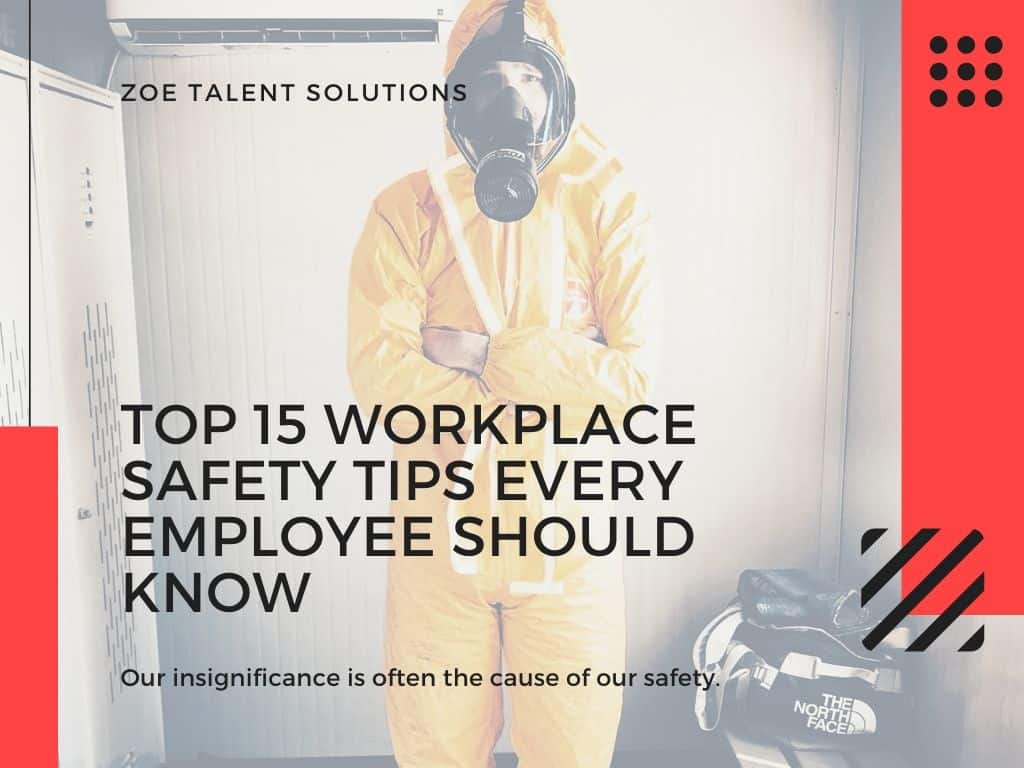In today’s advanced world, it is not uncommon to come across sudden and unexpected cases of accidents and casualties that can occur anywhere, altering the course of lives of particular persons as well as groups too. Often a “don’t care” attitude or sheer negligence may result in considerable wounding with trauma to persons where accidents could have been avoided, to begin with.
Workplace mishaps can be dangerous, severely undermining the competence and health of the concerned workers. Hence the pressing need for evolving a more safe and sound work environment.
Undoubtedly, the most important and invaluable asset of any company is its workforce, and necessary procedures adopted by the management to avert injuries or perils is crucial.
A company is obligated to arrange for essential safety appliances and facilities, financing suitable training initiatives and supporting safety-related amenities.
Safety is of primary importance in any profession, and a trouble-proof secure work atmosphere would raise the morale of all employees especially those at work in more risky conditions.
A steady ongoing and healthy style of living in the absence of any harm or injury denotes safety. Safety, which in part is freedom from any injury or its threat, also is indicative of the measures of caution and protection undertaken by people to stop and curb losses arising through accidents and various hazards.
It concerns with improved health by enhancement in working conditions. Likewise, every source capable of inflicting hurt or harm to persons, their health, workplace property and atmosphere, should be investigated, identified and appropriate strategies taken in defence to counter them.
Its also not enough to be concerned with issues of safety alone, but due importance rendered to the workplace environment and overall well-being or health of employees.
A safe working environment is all-important for a business to achieve longstanding success, while also assisting to:
Curtail sick leave
Retain personnel
Reduce staff reimbursement
Increase production levels
Lessen situations of staff injury, disability, and ill-health.
In order to create and achieve a more safe workplace, employees need to realize the perils of any harmful behaviour on their part, take on a positive mindset and attempt for the required improvement.
This would also mean that employees have clarity as to the risks and dangers present by their jobs and able to avert them. Herein comes the absolute necessity of the company to prioritize and promote a safe and healthy workplace lifestyle.
Stated below are 15 vital safety tips which every employee should be up to date with for safer work culture and smooth running of everyday business.
1) Be mindful of your work environment
This indicates employees being aware of the risks and perils that could be linked with their particular jobs or workplace. Once you are accustomed to your surroundings you will be able to apply caution and avoid needless precarious situations.
Some likely high-risk points in the workplace could be located near kitchens, studios, storehouses, electronics, washrooms, and the like.
2) Take breaks
In this hectic and fast-paced work environment, there is a greater risk for ailments and injuries since the employees maybe be over-worked, exhausted and unable to concentrate. Breaks taken off and on will help you to keep afresh and focus well.
3) Report unsafe conditions
You may come across potential hazards or harmful situations in your place of work like unsteady tiles, damaged tables or chairs, ripped carpets, stray cables, wobbly steps, or even hurdles in passage areas.
Treat this as a high priority and report this to your superiors immediately who will take corrective measures to maintain safety culture. Sightings of leakage and spills too should be quickly reported and cleaned up.
4) Be prepared
It would be prudent to get familiar with all available emergency exits, especially those closest to your designated place at work, as also every avenue of escape on your floor, and the building.
Keep note of various signs put up at different locations to instruct/warn you of the possibility of any kind of danger or risk. Be clear in your mind of the course of action you will undertake in case of emergencies like that of a medical condition, power outage, diverse kinds of storms, physical assault and the like.
It’s crucial to maintain proper backup strategies to salvage data in the event of computer or electrical failures.
5) Fire Hazards
There is considerable damage to health and property each year due to the outbreak of fire often caused by negligence. An ideal way to safeguard the company against fire would be to instruct and train employees on possible causes of fire outbreak and the need to be vigilant.
Regular participation in fire drills would certainly help the employees to be better prepared for a fire emergency situation. It’s of utmost importance for staff to be advised of the use and location of fire extinguishers, as also that of fire hose reels and blankets to contain the fire. In the event of fire evacuations, it would be best to use the staircase and not the elevator.
6) Good Posture
Whether your job requires you to be in an office setting or a manufacturing plant, it takes an effort to maintain a good posture, which is extremely pivotal in order to preserve you from chronic shoulder, neck or back pain and injuries too.
A good posture in your workplace would enable you to walk, sit or stand in a manner placing minimal pressure on your muscles whilst lifting up objects without unnecessary twisting, or bending to pick up something in the right way, or attending to your desk job too.
Poor posture may be the result of stress, sitting or standing for too long in the same position, tired postural muscles, obesity, unsatisfactory working conditions, and so on.
An intentional effort on your part to be aware of the right posture required to carry out your work commitments, and executing the same, would be beneficial to your well-being in the long run.
7) Be Sober
While at work you need to be focussed and concentrate well while displaying sound judgment and acumen at all times. The use of alcohol, as also drugs, including prescription drugs, is known to lower an individual’s inhibitions and affect their perception, coordination and the ability to be sufficiently attentive at their respective jobs.
Lapses can occur thus increasing the probability of injury and hence the utter need for the refrain of the use of drugs and alcohol at the workplace.
8) Reduce Stress
Workplace stress is rampant everywhere. Factors like work overload/long hours of work, conflict with colleagues or bosses, job insecurity, or a negative work atmosphere can deter your ability to concentrate on your required task.
Indigestion, chest pain, aches and pains and fatigue are some of the physical symptoms of stress, while depression, lack of confidence, frustration and irritability are a few psychological outcomes of stress.
Whether the stress level is mild or more severe, stress can undermine your ability to work efficiently and competently. An anxious troubled mind would prompt needless injury or illness you could definitely do without, and hence the fervent application of stress relief measures to be adopted.
9) Proper use of tools
It’s imperative for staff involved in working with different tools and equipment to utilize them correctly completely avoiding shortcuts at any point. One of the foremost causes of workplace-related mishaps and injuries are shortcuts.
No matter what the level of urgency may be, it’s wiser and safer to be cautious, abstain from alternate or quick-fix measures, and as trained, accomplish the task set before you. Appropriate reminders through regular training courses on health and safety would help emphasize this point.
10) Mechanical aids
It is an undeniable fact that lifting is responsible for most workplace injuries concerning muscle and bone. Lighter items can be lifted by yourself without much ado.
For the lifting and shifting of heavier items, it is advisable and advantageous to avail of mechanical aids such as cranes, forklifts, hand/shelf truck, and conveyor belts.
These mechanical aids are specifically meant for the purpose of assisting you by minimizing physical labour thus making lifting of objects simple, trouble-free and safer.
Staff should be suitably trained in the handling of lighter and heavier materials to avert needless situations of harm and injury that could occur at work.
11) Maintain clean/tidy workplace
A clean, polished and neat workplace will help diminish incidents of stumbling and slipping caused by items strewed across the floor. A stressed employee, whose ability to grasp and perceive things have scaled-down is liable to make mistakes, be clumsy and prone to mishaps.
Aisles that are clutter-free, well organized and tidy will ensure no hindrance leading to injury in the path of your fellow workers. Furthermore, it would be practical to avoid partaking of refreshments near your computer since crumbs/spills can enter the keyboard giving rise to malfunctions.
12) Ergonomic furniture
Common workplace furniture and appliances like a suitable computer, chairs, monitor stands, and tables should be flexible to ensure that all you require can be reached easily, so as to rule out falling or any other mishaps while stretching for something. This will check needless strains and detrimental body postures.
13) Regular maintenance of tools
A thorough and regular maintenance of your equipment and tools is desirable to prevent breakdowns and malfunctions. In its absence, in the event of a crash, not only will all work come to a standstill, but an employee is likely to get injured in the process.
14) Distinct use of labels
There should be a distinct use of labels in sections where risky or more hazardous equipment is kept and stored, in addition to passage areas being well highlighted with proper signage wherever required. The main thing is to ensure that signs are accurately made and placed in appropriate positions clearly visible to the employees.
A handy step would be to mark certain high-risk spots with tape or even have the floor painted with black and white lines. These measures adhered to faithfully will definitely lead to employees being more vigilant of their workplace unsafe zones, and helping them avert any possible mishaps leading to injuries.
15) Be responsible for your own safety
Your individual safety is your foremost responsibility. Life is precious: rather than be remorseful after an injury, its imperative to maintain an attitude of caution, begin implementing all safety measures beneficial to you while promoting safety at work. As per the requirement of your job, wear appropriate clothing as well as safety equipment.
When in need of help, request for the same. Safety appliances are not to be avoided. Check tools before use. Be careful when undertaking a task under pressure or in a hurry, as hurrying could lead to carelessness, and carelessness could then culminate in an accident.
A firm commitment on your part towards a safe work culture will enhance your productivity and provoke your co-workers to think likewise.
In conclusion, it can be stated that scores of people are affected by workplace injuries, illnesses or accidents, primarily due to a dire lack of knowledge and awareness of safety measures and amenities available to them. Where it has been said that prevention is certainly more desirable and better than the cure, a well thought of safety plan formulated to ensure a secure working environment is an absolute necessity.
The responsibility of achieving this safe work culture belongs to all and every staff member can help attain this goal. Prudence and effective communication curtail the prospects of you getting injured. But it would do well if the management is determined in motivating their employees to be diligently involved in implementing safety measures.
To be forewarned is forearmed, and by paying close attention to the above-mentioned safety tips as also having it shared with many, you will be contributing in warding off any damage, injuries or even perhaps death that could occur at your workplace.










